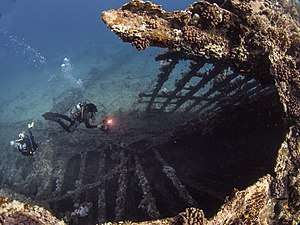SS Carnatic
SS Carnatic was a British steamship built in 1862-63 by Samuda Brothers at Cubitt Town on the Isle of Dogs, London, for the Peninsular and Oriental Steam Navigation Company. She operated on the Suez to Bombay run in the last years before the Suez Canal was opened.
 Print of the wreck of the Carnatic, 1869 | |
| History | |
|---|---|
| Name: | SS Carnatic |
| Operator: | Peninsula & Orient Steam Navigation Company |
| Builder: | Samuda Brothers, Cubitt Town, London |
| Laid down: | early 1862 |
| Launched: | 12 June 1862 |
| Completed: | 25 April 1863 |
| Fate: | Wrecked, 12 September 1869 |
| General characteristics | |
| Type: | Steam clipper ship |
| Tonnage: | 1,776 GRT |
| Length: | 89.4 m (293 ft 4 in) |
| Beam: | 11.6 m (38 ft 1 in) |
| Draught: | 7.8 m (25 ft 7 in) |
| Propulsion: | Humphrys, Tennant and Dykes 4-cylinder compound inverted steam engine, 2,442 hp (1,821 kW), single shaft |
| Sail plan: | Full-rigged ship |
| Speed: | 12 knots (22 km/h; 14 mph) |
| Capacity: | 250 passengers |
| Notes: | 31 persons lost in the shipwreck |
In 1869, she ran aground on a coral reef in the Red Sea and broke apart the following morning, with the loss of 31 lives. Her wreck was rediscovered in 1984 and is now a popular scuba diving site.
Ship history
The ship was laid down in early 1862, and was originally to be named Mysore. She was launched as Carnatic on 12 June 1862, and completed on 25 April 1863. The iron-framed wooden-planked hull was fitted with square-rigged sails, and also had a 4-cylinder compound inverted steam engine by Humphrys & Tennant, providing 2,442 hp (1,821 kW) to a single propeller.[1]
Grounding
On 12 September 1869, she ran aground on Sha`b Abu Nuhas coral reef near Shadwan Island at the mouth of the Gulf of Suez in the Red Sea. Having assessed the ship to be safe and the pumps intact, Captain P. B. Jones denied passengers' repeated requests to abandon ship, and reassured them that the ship was safe and that the P&O liner Sumatra was due to pass by and would rescue them. There was a general air of calm and normality on board until about 2 a.m. on the 14th, when the rising water engulfed the ship's boilers and the ship was left without power or light. At 11 a.m. the following morning, after 34 hours on the reef, Captain Jones had just given the order to abandon ship and the first four passengers had taken their seats in one of the lifeboats when Carnatic suddenly broke in half. Thirty-one people drowned. The survivors made it to barren island of Shadwan, where the next day the Sumatra rescued them.
Carnatic was carrying £40,000 worth of gold (well in excess of £1,000,000 in modern terms), so the wreck was the subject of a salvage operation two weeks later. All the gold was reported recovered, but persistent rumours of remaining treasure have added to the romance of the ship.
Captain Jones was recalled to England to face an official Board of Enquiry, which labelled him "a skilful and experienced officer." However, they also found "it appears there was every condition as regards ship, weather and light to ensure a safe voyage and there was needed only proper care. This was not done, and hence the disaster." Although Jones's Master's certificate was suspended for only nine months, he never returned to sea.
Rediscovered in May 1984, the wreck of the Carnatic is now a popular scuba diving site.[2]
In fiction

In Jules Verne's 1872 novel, Around the World in Eighty Days, Phileas Fogg intends to take a steamer named Carnatic to travel from Hong Kong to Yokohama, but misses it. His valet, Passepartout, catches the ship, however.
See also
- Lists of shipwrecks – Index to Wikipedia's lists of shipwrecks
References
- "Carnatic". shipwrecksofegypt.com. 2010. Archived from the original on 26 January 2013. Retrieved 28 February 2013.
- "SS CARNATIC. Wreck Directory & Diving Guide". aquatours.com. 2012. Retrieved 28 February 2013.
External links
- Middleton, Ned. "Egypt Red Sea Shipwrecks - The Carnatic". touregypt.net.
- A victim of the Carnatic disaster
| Shipwrecks |
|
|---|---|
| Other incidents |
|